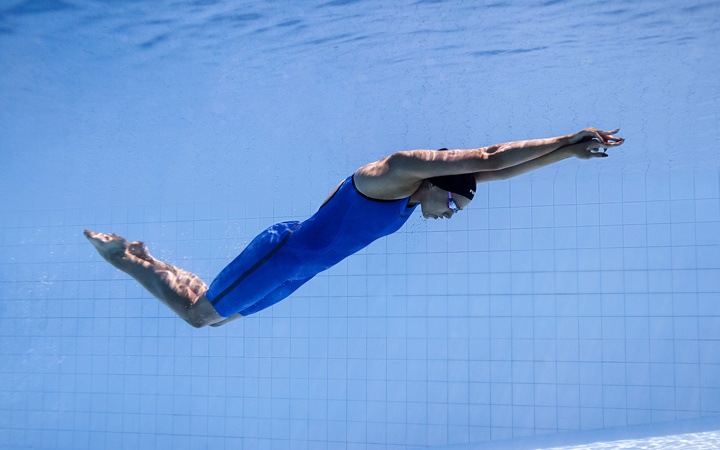If you want to practice the Butterfly on a competitive level, first of all, you need to practice the movement which is its basis: the undulation technique. This technique is based on the movement of the body in the water, and it requires much higher energy dispersal compared to other techniques.
Let us look more closely at this swimming technique: undulation is achieved when the body is in a curved position and the head pushes upwards and downwards so that the entire body moves producing an undulation. This allows the body to slide in the water without the need of leg and arm movement, and this, in turn, allows athletes to save on the amount of energy applied and optimizes the movement.
We know that the center of gravity of a body which is floating in a prone position is the lumbosacral region.
The undulation phase includes two important actions which allow the body to move forward near the water surface. The first phase starts when the head moves downwards and the chin touches the chest. This movement moves the athlete’s shoulders and back downwards. During this first phase, the body acquires downward speed.
Athletes can be instructed to execute an opposite pelvic movement, which is an upwards pelvic movement, so as to acquire speed.
The second phase starts as soon as the swimmer feels that his/her body is moving downwards smoothly and with the required speed. More specifically, the second phase starts when the athlete’s head quickly moves upwards, the forehead emerges from the water and the swimmer slightly curves his/her back so as to be able to exploit the speed which was acquired in the previous phase and delicately pushes the pelvis/bottom downwards so as to intensify the movement and make it smooth and harmonious.
One of the most common mistakes I have seen my colleagues make is to ask their athletes to use their legs before they have learned the correct undulation technique.
In order to correctly acquire this technique, leg movements must never be required – legs will move as a consequence of the undulation only. Leg movements must only be required once the athlete is able to perform the undulation technique impeccably and perfectly over long distances.
Based on my coaching experience, I would like to suggest that the use of legs too soon in this phase will make undulation look contracted, sudden, and the center of gravity will have to support an unnatural movement of the back and of trapezius and intervertebral muscles.
This happens because, in this case, the swimmer will strongly push the body downwards and upwards but his/her body will not create the undulation movement, which is the movement which will not stress the athlete’s back. The complete Dolphin Kick also includes the breathing technique, along with undulation. It is possible to breathe at every stroke cycle or every other stroke cycle. During undulation, air can be taken in frontally and/or laterally, then the stroke cycle will start in the water, the head will go back underwater and the arms will complete their movement in front of the head, slightly above the nape.
The function of the arms is to find an anchorage in the water which will give stability to the action and which will advance the body. The function of the legs is to support the undulation created by the head movement. Therefore if you do not work specifically and in a structured way, you will never obtain a Dolphin Kick with perfect undulation.
What suggestions can we give our athletes in order to help them improve their Dolphin kick and in order to facilitate them?
There are in-water training exercises, such as flip turns, which are useful to learn to arch the back, or touching the bottom of the swimming pool, so as to push the head downwards and make the body follow it.
At the gym, there are many possible out-of-water training exercises which will help athletes fine-tune this swimming technique, such as exercises with the medicine ball. In this case, athletes may lie down in a prone or supine position and, following the movement of the ball, will adapt the body to the shape of the ball simulating the undulation. An alternative is the execution of rolls on a soft mat, so as to concentrate on the movement of nearing the head to the chest, and so on.
A complete Dolphin Kick requires a perfect undulation technique, and the longer the competition, the more the swimmer will have to perform these phases perfectly, as they require little energy dispersal but extreme coordination of HEAD and PELVIS.
In a methodological sequence from undulation technique to full Dolphin Kick we will have:
- undulation without arm and leg movements
- undulation with arms next to the ears
- undulation with dolphin stroke
- vertical, supine and lateral undulation
- undulation with supports such as: flippers, mouthpiece, swimming board
http://folk.ntnu.no/oivarn/hercules_ntnu/LWTcourse/lwt_new_2000_Part_A.pdf
http://jeb.biologists.org/content/214/4/561

In this point, the swimmer increases the speed to support this motion.

Application with the greatest.
https://www.youtube.com/watch?v=jd67PMryIT0
Hi Bobo,
Thank you for your video and comment.
As you can see in Michale Phelps’s video four steps during his stroke:
1 head up to take breath
2 arms ready to get out of the water
3 head down
4 arms close stroke in front head.
Michael keeps chin close top of water,when his head is out the water and then chin down in the water to keep undulation motion close surface water line.
Look the wave picture.
he manages to keep his balance right even when his head moves downward (end of exhilaration)and his pelvis moves up to increase the speed of the technical gesture with minimal expenditure
Hi. Butterfly looks so easy with MP.
I can advice to look this swimmer:
László Cseh,Hungary swimmer.
His technique is completely different than MP.
His arms close in the middle of his body and when he takes breath look his chest outside water.
https://youtu.be/V0k4IQK9Gk8